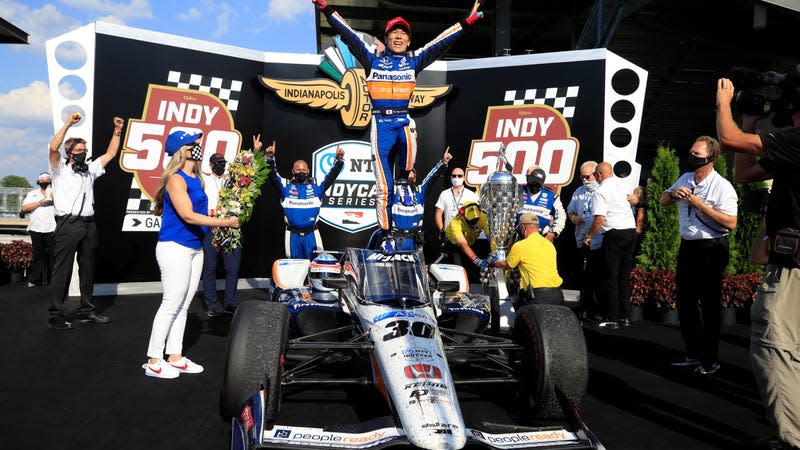The Wildest Indy 500 Records Ever Set

With over a century of history under its belt, it should be no surprise that the Indianapolis 500 has racked up an impressive list of records, legends, and myths to accompany the grand scale of the race. Today, we’re looking at some of the weirdest “firsts” that have taken place at the track — from the first driver to finish both first and last in the 500 to the first 500 that ever took place on a Sunday.
1913: The First Winner Without a Relief Driver
Road to 100: 1913
While we tend to remember a singular yearly winner at the Indy 500, for the first few runnings of the race, it would probably be more apt to talk about winners, in plural. That’s because the grueling nature of the race often required a car’s main driver to take a break. A relief driver would hop in for a few laps and have at it before the main driver got back behind the wheel. But when Frenchman Jules Goux won the 500 in 1913, he became the first winner to go the full race distance without a relief driver. He was also the first French and European champion the race had ever seen, and his Peugeot was the first car to win with wire, not wood-spoke, wheels.
Read more
1920: The First 500 Winner to Die
Gaston Chevrolet wins the 1920 Indy 500
There would inevitably come a point where a former winner of the Indy 500 would die, but that end came quickly for Gaston Chevrolet. He won the 500 in 1920 and was killed in a board track race in Beverly Hills before the end of the year.
1921: The First Driver to Finish Both First and Last
Road to 100: 1921
Howdy Wilcox might have one of the greatest names in motorsport history, but he also has a few records to his name. In 1919, after winning the race, the crowd serenaded the local racer with Back Home Again in Indiana. That marked the first time the song was performed at the race and has become a mainstay of pre-race ceremonies. (His car, too, was entered by the Indianapolis Motor Speedway itself, making it the first winning entry to be directly affiliated with the track.)
But when Wilcox was classified dead last in the 1921 Indy 500, he became the first driver in the race’s history to finish both first and also last.
1936: Tradition Is Born
1936 International 500-Mile Sweepstakes Race
The 1936 Indy 500 was a big year for tradition. When Louis Meyer celebrated his victory, he did so with a glass of buttermilk, something that has become an inseparable act for modern winners after the race. Meyer was also presented with the now-iconic Borg-Warner trophy, which made its first appearance in 1936, and also was the first driver to take home the pace car as a prize.
1950: The First Rookie on Pole
1950 Formula 1 Grande Premio de indianapolis 1950
Discounting the first-ever running of the Indy 500 where everyone was a rookie, Walt Faulkner became the first rookie to ever qualify for pole at the race back in 1950.
1958: No Front-Row Starter Led a Lap
Thrilling 1958 Indianapolis 500 Auto Race - rare film
While it can be tough to predict every driver to lead the 500 in any given year, the sheer speed of the three front-row qualifiers generally means you can expect one, if not all, of them to lead a few laps at one point or another. In 1958, though, all three front row drivers — Dick Rathmann, Ed Elisian, and Jimmy Reece — failed to manage to lead a single lap.
That was due to some confused race direction that ultimately resulted in Elisian spinning Rathmann into the first turn on the first lap. Pat O’Connor slammed into the back of Reece, the former of whom was killed in the crash. As a result, no front-row car led a single lap.
1966: Rookie Winner Isn’t Rookie of the Year
1966 Indianapolis 500 | Official Race Film 1080p
In 1966, rookie Graham Hill won his first-ever 500. You’d think that would make him a shoo-in for Rookie of the Year, but that wasn’t the case; instead, the ROTY honors were handed to Hill’s teammate Jackie Stewart.
ROTY is decided by a popular vote, and Stewart had earned the respect of his fellow 500 competitors by running much of the race in the lead. With just 10 laps remaining, however, Stewart lost oil pressure, and Hill took over the lead. Stewart likely would have won had it not been for the oil failure, and his performance made him worthy of a different kind of recognition.

 Yahoo Autos
Yahoo Autos 